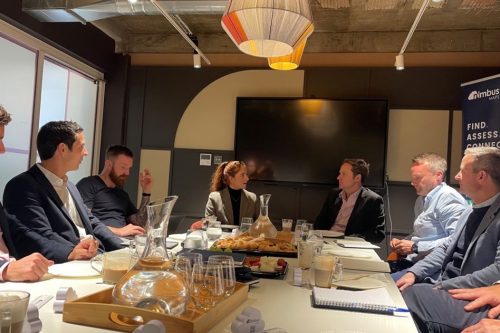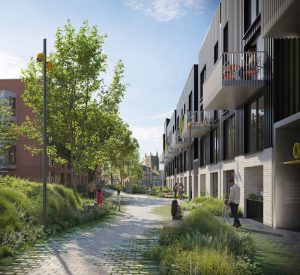Property round table report: Where is best to invest?

Following a period of significant change, a panel of commercial property experts joined a roundtable discussion with Nimbus Maps, to discuss the general market sentiment in Birmingham.
Everyone is being impacted as a result of high inflation, interest rates and energy prices rising alongside the ongoing war in Ukraine and the aftermath of the pandemic.
Our panel revealed where they would place their money now during these uncertain times.
The hospitality industry was faced with many challenges during and following the pandemic, especially managing customer safety and adhering to restrictions.
Noel Moffitt, corporate director at Christie & Co said many people rushed back to spending money post-pandemic. He said: “If you’ve got some cash in your pocket, invariably you’ll go out and eat and drink and use hotel accommodation. What we’ve seen, certainly pre pandemic, trade has been robust. Occupiers have had to be very flexible, reinvent themselves and invest in their businesses where possible. There was a huge amount of government backing, which really helped.
“It was all looking very positive until the war in Ukraine and then of course the energy crisis. The main issues for the hospitality industry at the moment are energy, staffing and inflationary food costs”.
“People wanted to feel comfortable in a restaurant environment. They didn’t want the screens at the till or screens at the meeting point, they just wanted a bit more space with a few less tables. Those that still managed their businesses and created a comfortable environment did very well and a lot of them were in excess of their 2019 trading figures”.
Thoughts then turned to what these challenges have had on yields in the capital markets.
Ashley Hudson, partner and office head of Birmingham’s Knight Frank said: “Right now, we’re in a dip. Debt is difficult and very expensive and that is the biggest problem on the capital side of the market. You’ve got to remember that the investment market has been fueled by very very cheap debt for 15 years, which is an unusual situation that has never happened before because of the GFC.
“I think that that just cannot continue. It’s got to correct so you know, the new interest rates might be the new norm and yields may never get down.
“The buyers that we’re working with are active and the buyers that have been priced out for quite some time. So whether it’s private wealth from the UK, or whether it’s Middle Eastern wealth – it has to be equity as equity is very valuable and everybody knows that equity is very, very valuable and they’re treating it so. So whilst we have the dip after the summer. There are a few buyers thinking they’d be quite active but then pricing continues to slide, so now they’re being very, very selective in the deals that they’ll do”.
“Things like Goldman Sachs happening in Birmingham really puts us on the map as well as the Commonwealth Games. Investors will have heard of London, they won’t have heard of Birmingham but they’ll have heard of Goldman Sachs”.
Richard Tole, director of Hamilton Tole, echoed the uncertainty around yields saying that: “One of the clients I’ve been working with recently is Asda, who are looking to roll out a convenience store model so I’ve been helping them out in the Midlands. There’s a lot of questions about where yields are and the first adventure is that people think there’s not a lot of attractive stock out there. There’s no real evidence at the moment to see where yields are. It makes quite a big difference in terms of the valuation side”.
For Carl Potter, managing director at Avison Young, this isn’t the only headwind. Potter said: “We’ve lived on development finance over the last few years, between five and 6%. It’s now about 9.5% at the moment so once you start to introduce those levels of borrowing into development appraisals, it all goes the wrong way.
“If there’s a long term proposal where you may be developing this in two to three years time you can think about what is the level of debt at that point in time? What is the level of interest? What can I afford to pay for the sign out and live off that debt compared to how I can develop in the future – which is all fine if you’re well funded. If you’ve got bank funding, private equity funding, you’ve got to be able to prove that and that’s really difficult”.
As major players like Goldman Sachs move into Birmingham’s city centre, Simon Davis, co-founder of Nimbus Maps asked Kelvin Craddock director at JLL what occupier demand looks like now?
Craddock said he believes that it will probably hit the five year average again this year but what he has also seen is a, “slight drop off in the number of new inquiries coming into the market. A bit of uncertainty just means people hit the pause button.
“If you look at the take up so far this year, about 53% of it has been grade A, so there’s very much been a flight to quality and people have taken a little bit less space that they probably would have done previously. Grade A buildings have really stood out over the last couple of years. They have been the best located, best quality and ESG is a huge part of it”.
Whilst many companies are looking for Grade A space, many are considering Grade B buildings that can be refurbished to improve the quality.
“If you look at Grade A sites, they are larger buildings with more floor space. If you look at the demand in Birmingham from transactions from this year, I think the average deal size is down by about 1,000 square feet compared to some of the historic averages.
“But actually the volume is back in terms of the number of transactions – I think it’s probably as high as it has been for more than five years in terms. There is still a lot of demand in the grade B market as rents have moved on and they’re still very good buildings”.
Craddock said: “We’re seeing a huge focus on ESG – I think there’s been a lot of focus on ‘E’ to start with but the ‘SG’ part is becoming more than active.
“A lot of the focus has been on the new build stuff in the city but there are a few occupiers that have said we shouldn’t be going to a new build necessarily, we should be looking at a refurb building. From an environmental perspective and embodied carbon within that building, we’ve been getting decent quality refurbished stock. Actually, the refurb rents and where they’re being guided aren’t far off new build”.
The industrial sector is also having to face upgrades to buildings to ensure they can remain operating. The Government has recently set a target of lifting the minimum energy efficiency standard to let non-domestic buildings to ‘B’, as part of its target for the UK being net-zero by 2050. From 2025, under the current proposal, all newly rented properties will be required to have an EPC rating of C or above. Currently, properties only require an EPC rating of ‘E’ or above.
Ed Siddall-Jones, director of Siddall Jones said that: “We’re working with a number of our clients at the moment about improving their energy efficiency and it is worrying. If you look at industrial stock who have got secondary sheds all over the country – they’ll be non-compliant in the not too distant future. So we’re working with people trying to get the best energy efficiency”.
The flexible space market has rocketed since the pandemic, with more companies adapting to new working practices and providing smaller but better quality spaces to attract fresh talent.
Commercial manager of The Boutique Workplace Company, Daniel McLeod operates flexible workspaces at 102 Colmore Row. He said: “We had an agreement with Arcadis during their transitional period before they moved to 103 Colmore Row. Now that they’ve moved they’ve taken less space than they had before so they have an agreement with x+y on floors two, three and four that if they need any flex space they can just move into that – it kind of kills two birds with one stone.
Knight Frank recently moved into the Grade A landmark building – 103 Colmore Row – a move Ashley Hudson says was to embrace quality for the war on talent, to get people in the office.
“In our old offices we had two boardrooms that we used once a month at most, and we haven’t got boardrooms now. We moved to our new building as a core office and then we’ve got the flexible operator in the building and if we need to go and have a big board meeting or rent it for half a day, we can”.
McLeod discussed how the flexible market massively benefited from the uncertainty of the pandemic. He said: “Big corporations are coming out of large spaces into flex such as Arcadis, reducing their costs by 30 – 40% because of the lack of square footage, so they’re willing to then invest in something that’s more flexible.
“When we went through the pandemic, initially, The Boutique Workplace Company dropped our portfolio percentage from 96% occupied occupancy down to 45%. We’re now turning over more at 75% occupancy as a portfolio than what we were at 96%”
For Carl Potter, the flexible market is where the opportunity for capital growth is coming from next year. Potter said that people will, “pay 45 per square foot because I’m taking 25 – 40% less space than I’m in at the moment. And if I find the right space that allows me to have really agile working with some add ons – flex is worth a lot of money to a business”.
“Better quality spaces are attracting better talent through the door”, said Siddall-Jones.
“We’ve noticed people paying more price per square foot to get people back in the office, we want to attract better candidates, and we’ve got to pay more price per square foot.
He used an example of a client that Siddall-Jones recently helped move to the Jewellery Quarter, “who is paying 16 per square foot when he used to pay 12. He has added a golf simulator in for some staff camaraderie and for clients and the directors – people have loved it”.
Many offices are adding bespoke features and perks to their space such as a gym.
McLeod said: “We’ve got a gym here and clients love it. They don’t necessarily see it as something they can use themselves but see it as something that may attract a younger caliber of talent to work for them”.
Davis asked whether there needs to be a shift in looking across the board from commercial to residential?
Mark Weller, director at Lambert Smith Hampton said: “If you look at Sheldon, a lot of office buildings have been converted to residential. I think with what’s happening with the construction market with the cost of debt, that is going to impact your smaller developers who would typically look at your conversion schemes.
“The cost of new builds is similar to conversions, but in the more peripheral locations that aren’t the strongest, you probably haven’t got the level of value there and sales value is heavy, so you have to be realistic on price”.
Several regeneration projects are taking off across the region, but does there need to be better engagement with the local authorities to support these opportunities?
Avison Young have got a three year framework with Coventry city council to look at their property management and make better investments. Potter said that this has been “really important” as the city council is “aligning its investment portfolio with regeneration and making sure the investment it makes matches the needs of the people. Investing its money into longer term regeneration propositions that maybe sometimes the private sector won’t look at – is always going to be a good outcome.
“Coventry Friargate for example, is the part of Coventry that has grown strongest at the moment. It’s helped with the regeneration of the rail station and created a gateway to really good quality public rail from the train station into South Coventry. Without that you wouldn’t have seen the new South Coventry redevelopment that’s just starting to get underway. So these can be really positive triggers to help regeneration and it’s all about connectivity and making sure the city centre is joined up and legible”.
To conclude the discussion, Simon Davis of Nimbus Maps said to each attendee: “If I were to give each one of you £5m to invest in property, I would want it back in three years time and you can have 50% of anything that happens on that £5m – what would you invest in today?”
The responses were:
Mark Weller: “I spoke to a client yesterday who’s got quite a few small estates, some sub 10,000 sq ft units that come on the market and he said there’s always tenants waiting to move in. So I think the occupier market on the smaller industrial side is pretty strong”.
Richard Tole: “I would have to say EV. Some people are on the fence on whether it will be the solution, but in terms of that marketplace the number of players and the demand for space is high”.
Noel Moffitt: “I’d look at the hotel and care sectors because they’re still thriving. We have such a shortage of bed space with an ageing population. Hotels have gone from strength to strength, due to COVID as people are looking at staycations in the UK more and more as part of their holidays throughout the year”.
Ashley Hudson: “I think I’d be choosing my vendor very carefully. It’s not so much sector or particularly property type, I’ll just be careful choosing my vendor. We have clients who are a fan of value add office refurb investors and they’re starting to look at well let shiny sheds because well led shiny sheds have gone from three and a half outdoors to five and three quarters, six and beyond.
“If you think about wealth preservation, you can get your six plus percent with a 20 year lease, you might get an uplift in five years time. And then you might get some yield compression when the market comes back a little bit”.
Carl Potter: “I’d put my money into senior living. The strength of the occupier market underpins the value of property and there are more people getting older.
“I think people are reflecting now as they get older as to what they want from life and there is less emphasis on continuing to live in the house I’ve always lived in and seeing the benefits of moving to rented accommodation, or purchased accommodation that provides a service.
“Over the next few years we’ll see a reaction in that market that mirrors the buy to rent market, and that’s underpinned to some extent by students who have purpose built student accommodation – they get all services added in so you don’t have to worry”.
Ed Siddall-Jones: I would absolutely put my money into sheds. I think the secondary market will dip over the course of the next few months. I think there’s opportunities to buy secondary kit.
“With sheds, you can rip off the cladding and reclad it – looks like a brand new unit. You can carve it up into small units. Just to give you an example, we’re getting on city council industrial estate in Winson Green 12 pounds per square foot for smaller units, which is comparable to office rents in our city fringe”.
Kelvin Craddock: “I would also say senior living as well, but I also think investing in industrial land is not a bad shout as pricing comes off in the longer term”.
Daniel McLeod: “I think with the uncertainty that keeps coming in whether it be Ukraine, a change of sovereign or COVID – flexibility is key. The more flex you get, the more bullish you can be on rates. We charge more per allocation of workstation or square footage, the shorter the contract – people pay for the flexibility ultimately.
It’s along the same lines as senior living – people want services and as long as you’re on point and your services are good then I think you’ll always do well”.
Thank you to our expert panel for a fascinating discussion and to our sponsors Nimbus Maps.
Simon Davis – Nimbus Maps
Ed Siddall-Jones – Siddall Jones
Daniel McLeod – The Boutique Workplace Co
Kelvin Craddock – JLL
Mark Well – Lambert Smith Hampton
Carl Potter – Avison Young
Ashley Hudson – Knight Frank
Noel Moffitt – Christie & Co
Richard Tole – Hamilton Tole
Anna Cooper – The Business Desk









